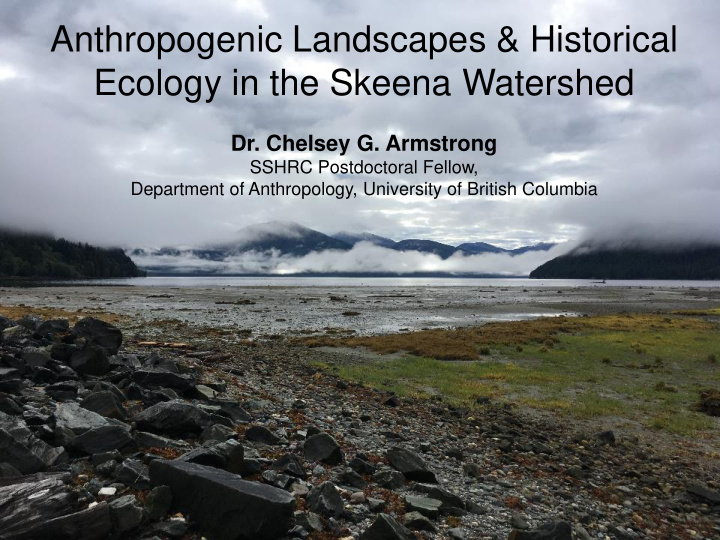



Anthropogenic Landscapes & Historical Ecology in the Skeena Watershed Dr. Chelsey G. Armstrong SSHRC Postdoctoral Fellow, Department of Anthropology, University of British Columbia
Skeena Watershed
The Anthropocene
3,500+ Years of Land Use
Húyat, Heiltsuk Territory www.hauyat.ca
Tsm’syen villages 1,500 / 2000 ya Martindale and Marsden 2003
~1700 AD Martindale 2009
Today • Documenting ancient and ongoing land- use patterns in Skeena Watershed • Untangling social-ecological dynamics • Plant translocations (species) • Enhancement of novel ecosystems, resource management (niche space/ landscape) • = complex biophysical and cultural interactions over 1000s of years • “Positive” vs. “Negative” impacts
Acknowledge and Thanks Nancy Turner Richard Wright Christina Stanley Dana Lepofsky Tony Mclean Morgan Ritchie Dawn Charlie Spencer Greening Leslie Main Johnson
Translocations
Hazelnut ( Corylus cornuta, Betulaceae)
Hazelnut ( Corylus cornuta, Betulaceae) “ Around our home yeah, you take hazelnut … just plant them so that they’re all together … that was my job in the spring. So when you go out to harvest them in the fall, they’re all in one spot …more like we do with apples … . You know, you transplant them.” Marion Wal’ceck w u Dixon (Nlaka’pamux) Marion in the Coquihalla, 1939
Modern Hazelnut Distribution Southern variety ( Corylus cornuta var. californica ) Interior variety ( Corylus cornuta var. cornuta ) Disjunct/Isolate/Remnant?
Hazelnut Disjunct? Southern variety ( Corylus cornuta var. californica ) Interior variety ( Corylus cornuta var. cornuta ) Corylus californica ?
Hazelnut Paleobiolinguistics Gitxsan (Tsimshianic): [sgan] [ ts’ek ] Proto Salish: * [ ts’ik ] or * [ ts’ik’] Skwxwú7mesh: [ ts’ik ]
Hazelnut Distribution in Terrace
Hazelnut Pop Gens: 3/12 Microsatellites (SSR) Alleles in each “population”
Pacific Crabapple (Moołks, Malus fusca )
Pacific Crabapple and Siberian Crabapple Pacific Crabapple Siberian Crabapple
Pacific Crabapple Genome Project
Bringing Moołks Back to Old Town Łaaya no’os x x x x x x x x x x x x x x x x x
Ecosystem Enhancement (“novel ecosystems”)
Forest Gardens
Dałk Gyilakyaw (Robin Town) – Gitsm’geelm, Tsm’syen
Forest Gardens in BC Village Core Gitseax (Kitselas Canyon) Village Periphery Village Periphery
Indicator Species Analysis
Village Core Village Periphery Species Richness
Beyond Species Composition: Forest gardens more rich = likely to provide a suite of ecosystem functions that peripheral forests do not…
Beyond Species Composition: Forest gardens more rich = likely to provide a suite of ecosystem functions that peripheral forests do not… What are those functions?
Beyond Species Composition: Forest gardens more rich = likely to provide a suite of ecosystem functions that peripheral forests do not… What are those functions? Functional ecology uses plant traits to understand plant impacts on ecosystems
Beyond Species Composition: Forest gardens more rich = likely to provide a suite of ecosystem functions that peripheral forests do not… What are those functions? Functional ecology uses plant traits to understand plant impacts on ecosystems 3 traits (seed mass, pollination & dispersal syndrome) to compare functions between villages and peripheries
Functional Trait: Seed Mass
Functional Trait: Animal Dispersed/Pollinated
Forest Gardens and Sts’ailes Land Claims CMTs� Fuel� � Highbush� Cranberry� Huckleberries� Pacific� Crabapple� � Elderberry� � Choke� Cherry� � Hazelnut� � S@ nging� NeKle� � Riceroot� Lily� � Wapato� � Conifer- Dominant� Peripheral� Forest� Garden� and� Food� Forest� � Mix� Habita@ on� Area� Prepara@ on/Storage� Pits� � and� Forest� Garden� � � � � � Idealized� Forest� Garden� Landscape� Before� SeKler� Colonial� Displacement� Lepofsky, Armstrong et al. 2019
Luutkudziiwus Lax ’yip (Suskwa Watershed) 5 km
Canada Film Board 1946
Terra-forming Lithics and Fire Cracked Rock Black Midden Soils
Suskwa Cultural Landscape
Sim ma’ay Burning/Management (Black huckleberry, Vaccinium membranaceum ) Gathering What the Great Nature Provided , 1980
Sim ma’ay Burning/Management (Black huckleberry, Vaccinium membranaceum )
Global Land-Use and Climate Change.. “ We estimate that at least 28.1% of the world’s land surface is owned or managed by Indigenous Peoples, including some of the most ecologically intact and biodiverse landscapes remaining on Earth. ”
Anthropogenic Impacts ≠ Negative Impacts/Climate Change • Landscape modifications do not always produce negative impacts • Impacts are not stagnant • Relationship/interactions depend on a culture/community/society’s actions and values Adaptation through space and time? • D on’t expect the past to be a blueprint for the future… but … • We can learn how anthropogenic impacts effect species distributions and functions • … how they relate to applied issues of sovereignty and title • Social-ecological feedbacks are incredibly complex ! • But we should strive to model management practices that are designed by and for the right communities • Contribute to wiser management decisions in an uncertain future
Thank You Dana Lepofsky, Nancy Turner, Leslie Main Johnson, Alex McAlvay, Jesse Miller, Ken Lertzman, Morgan Ritchie, Christina Stanley, Storm Carroll, Tony McClean, Logan Kistler, Phillip Blundon, Denzel Sutherland-Wilson, Spencer Greening, Carilia Horning, Torben Rick, and Jim McDonald
Recommend
More recommend